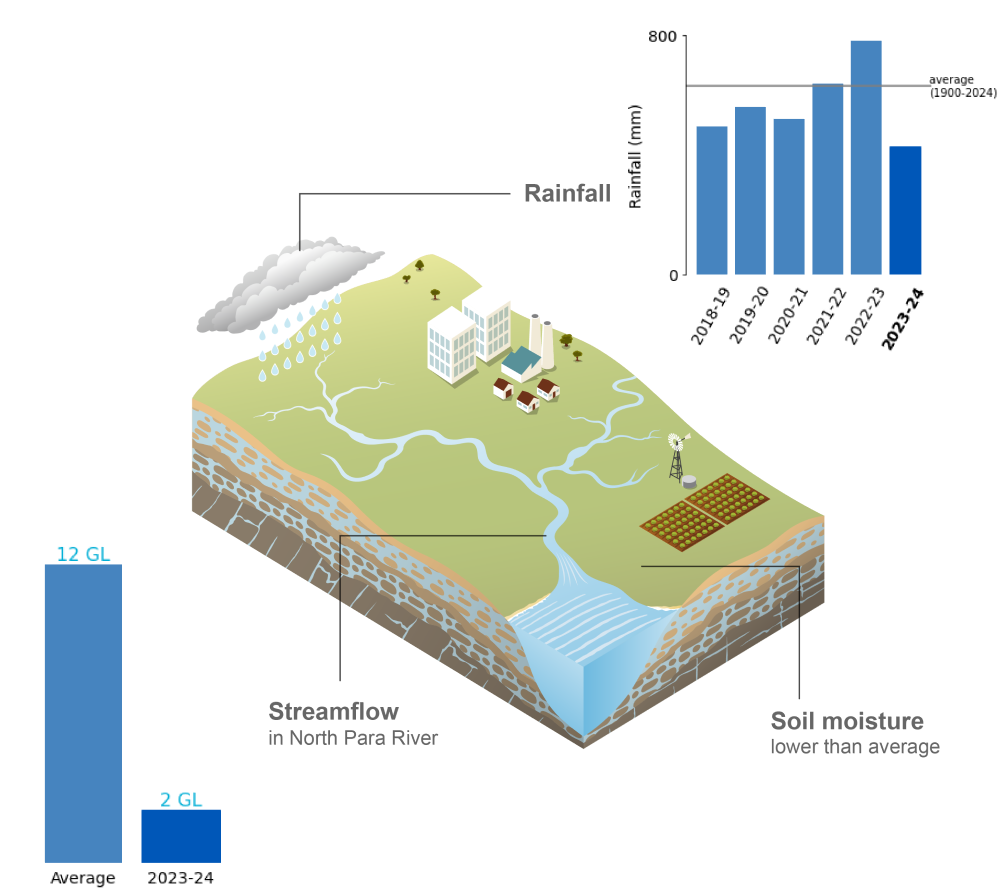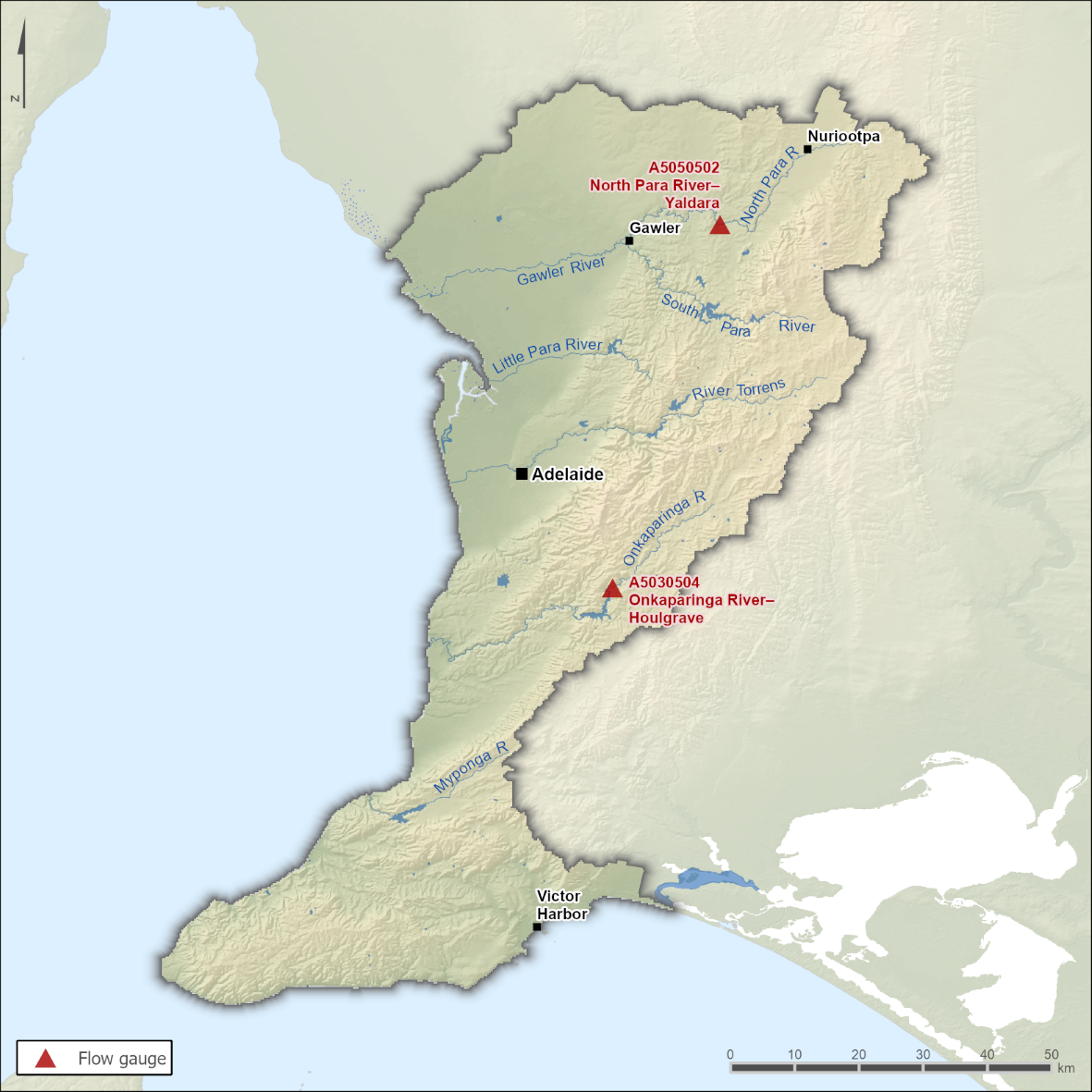Adelaide: Climate and water
For the water account period 1 July 2023 to 30 June 2024
- Annual rainfall in the Adelaide region during 2023–24 was the lowest on record, including the region's driest February-to-May period on record.
- Soil moisture in the root zone (0–1 m depth) was below average throughout most of the reporting period, except for the coastal fringes where soil moisture remained close to average.
- Total annual flows in the North Para River were very much below average, recording just 18% of the long-term average, reflecting the persistently dry conditions throughout the reporting period.

For further information on the region's climate and water conditions during the 2023–24 year scroll down this page or click on the links below:
About the region
- The Adelaide region experiences a Mediterranean climate, characterised by cold to mild, wet winters and warm to hot, dry summers.
- Most rainfall occurs from April to October, aligning with southern Australia’s wet season. Rainfall is typically unreliable and infrequent from November to March.
- Streamflows in the region’s rivers generally reflect the distribution of rainfall throughout the year. Generally, higher streamflows and storage inflows occur from June to August, while streamflows can cease to flow between December and March.
Climate conditions
Rainfall
Figure C1 Annual and monthly rainfall deciles for the Adelaide region during 2023–24
- Total area-averaged rainfall in the Adelaide region during 2023–24 was 428 mm, 32% below the long-term average of 631 mm, making it the region's driest year on record.
- Rainfall from July to October was 50% below the long-term average for this period, due to a lack of rain-bearing systems, with each month ranking among the top 20 driest for each respective month.
- In late September, a positive Indian Ocean Dipole (IOD) and El Niño event in the tropical Pacific Ocean were declared underway (as stated in this Climate Driver Update). Historically, concurrent positive IOD and El Niño events increase the likelihood of below-average rainfall, particularly during winter and spring, and likely contributed to the below-average rainfall observed from July to October.
- During the first week of December, a low-pressure system generated widespread heavy rainfall, resulting in the ninth-wettest December on record for the region, with many sites recording their highest December monthly rainfall total on record.
- By late January, the positive IOD returned to neutral, while the El Niño event began weakening, but despite their gradual decay, the region experienced its second-driest February on record, with little to no rainfall observed across the region.
- The dry spell continued into autumn, with the region suffering its second-driest autumn on record, receiving only 23% of its long-term average autumn rainfall—contributing to the driest February-to-May period on record for the region.
- At the end of autumn, the El Niño-Southern Oscillation returned to neutral, but despite its waning influence on the region’s climate, a low-pressure system and associated cold front broke the dry spell in June, with rainfall being close to the long-term June average.
- More information on Australia’s climate and water during the 2023–24 reporting period can be found in the Financial Year Climate and Water Statement 2023–24.
Figure C2 Total monthly rainfall for the Adelaide region during 2023–24 compared with the average and percentiles for the region
- Rainfall was above average from November to January, with December the only month to exceed the 90th percentile. Rainfall in June was close the long-term average.
- Of the seven months that recorded significantly below-average rainfall, only May ranked below the 10th percentile, while February equalled the 10th percentile. Rainfall in July, August, September, October, and April was just above the 10th percentile.
Actual evapotranspiration
Figure C3 Annual and monthly actual evapotranspiration deciles for the Adelaide region during 2023–24
- Total area-averaged actual evapotranspiration in the Adelaide region was predominantly average to below average during 2023–24, with below-average evapotranspiration more prominent in the north, as periods of low rainfall—particularly during spring and autumn—reduced water availability.
- Despite below-average rainfall between July and October, evapotranspiration was average to above average throughout winter and into spring, primarily due to above-average rainfall in May and June 2023 boosting water availability heading into winter.
- A lack of rain-bearing systems, combined with below-average temperatures in late winter and early spring, reduced water availability across the region, causing evapotranspiration to become below average across much of the region.
- Following the region’s ninth-wettest December on record, evapotranspiration rebounded to predominantly above average levels due to the boost in water availability, and remained above average across much of the region throughout January.
- After the region’s second-driest February on record, water availability declined, leading to a drop in evapotranspiration—particularly in northern areas.
- Evapotranspiration continued to decline throughout autumn, following the region’s second-driest autumn on record, with much of the northern half of the region experiencing its lowest evapotranspiration on record during May.
- In response to near-average rainfall in June, evapotranspiration increased slightly but remained below average across much of the region—particularly in the north—heading into winter.
Soil moisture
Figure C4 Annual and monthly soil moisture deciles for the Adelaide region during 2023–24
- Soil moisture in the root zone (0–1 m depth) for the Adelaide region was predominantly below average during 2023–24, except for the western and southern coastal fringes, where soil moisture remained near average throughout the reporting period.
- Despite rainfall being below average in July, soil moisture was average to above average across the region, due to the above-average rainfall in May and June 2023.
- Following a lack of rain-bearing systems throughout late winter and early spring, soil moisture declined rapidly, with very much below average conditions reaching their greatest extent in October.
- On the back of the region’s ninth-wettest December on record, soil moisture rebounded to above average levels across much of the region, and remained predominantly above average throughout January.
- After the region’s second-driest February on record, soil moisture decreased again, with below average conditions emerging in the north.
- Throughout autumn, soil moisture continued to decline, following the region’s second-driest autumn on record, with the northern third of the region recording its lowest soil moisture on record during May, reflecting the persistently dry conditions.
- In response to near-average rainfall in June, soil moisture increased slightly, but remained below average across much of the region heading into winter.
- More information on the soil moisture conditions across the Adelaide region during the 2023–24 reporting year is available on the Australian Water Outlook.
Streamflow responses

Figure C5 Key flow gauging stations along the main rivers within the Adelaide region
- Two gauging stations—Onkaparinga River at Houlgrave (Station A5030504) and North Para River at Yaldara (Station A5050502)—are used to represent the seasonal flow patterns of the Adelaide region.
- The Onkaparinga River provides major inflows to Mount Bold Reservoir, the region’s largest surface water storage. Flows in the North Para River are unregulated and not influenced by diversions for consumptive use.
- Flows in the River Torrens are highly modified for urban and flood control purposes; as a result, no gauging station is used to represent seasonal flow patterns, as flows may not reflect natural seasonal conditions.
Figure C6 Total monthly streamflow for major rivers in the Adelaide region during 2023–24 compared with the average and percentiles
- Total annual flows in the North Para River at Yaldara (Station A5050502) were 82% below the long-term average 12.4 GL in 2023–24, reflecting the region’s driest year on record.
- Flows in the North Para River during July were the highest of the reporting period, but remained well below average.
- A lack of rain-bearing systems from July to October resulted in exceptionally low flows during a period when streamflows are typically at their highest.
- Despite the region experiencing its ninth-wettest December on record, flows in the North Para River remained close to zero throughout summer.
- Following the region’s second-driest February on record, streamflows almost ceased to flow, and remained near zero in response to the region’s second-driest autumn on record.
- Streamflows remained close to zero through to the end of June. While streamflows are typically at their lowest between January and April, they were abnormally low throughout the reporting period.
Note: Due to technical difficulties reported from the Onkaparinga gauging station, no data was available for 2023–24.









